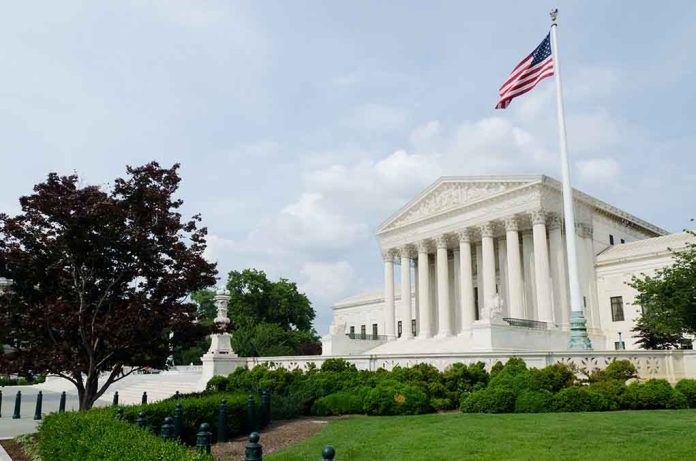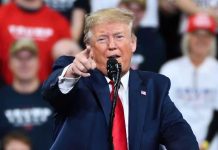
The Supreme Court has temporarily granted President Trump authority to remove two Biden-appointed board members while a significant constitutional battle over presidential power unfolds.
Key Takeaways
- Chief Justice John Roberts issued an administrative stay allowing President Trump to remove officials from the National Labor Relations Board and Merit Systems Protection Board.
- The case centers on a landmark 1935 Supreme Court decision (Humphrey’s Executor) that limits presidential power to fire independent agency officials without cause.
- The Trump administration argues that forcing the President to work with agency heads opposed to his policy objectives violates constitutional separation of powers.
- Conservative legal scholars have long criticized restrictions on presidential authority over executive branch appointees.
- The outcome could fundamentally reshape presidential control over federal agencies and impact Trump’s administrative priorities.
Presidential Authority at the Center of Constitutional Showdown
President Trump has asked the Supreme Court to affirm his constitutional authority to fire the leaders of independent federal agencies who oppose his administration’s policies. Chief Justice John Roberts has temporarily paused a lower court ruling that had reinstated two board members initially appointed by Biden – Gwynne Wilcox of the National Labor Relations Board and Cathy Harris of the Merit Systems Protection Board. The temporary stay gives the Supreme Court time to consider the broader constitutional questions about presidential power raised by the case.
The confrontation stems from President Trump’s efforts to remove officials he believes are obstructing his administration’s policy objectives. The case strikes at the heart of a decades-old Supreme Court precedent from 1935, Humphrey’s Executor v. United States, which established limits on presidential authority to fire certain independent agency officials without cause. Conservative legal theorists have long criticized this ruling as an unconstitutional restriction on executive power granted by Article II of the Constitution.
Trump vs. the Constitution: The Legal and Institutional Challenges of an Unconstrained Presidency
The second Trump administration presents a fundamental test for the resilience of the American constitutional system. With his return to power, the legal and institutional…
— Niels Groeneveld (@nigroeneveld) March 10, 2025
Solicitor General Pushes for Presidential Control
Solicitor General D. John Sauer has taken a strong position in court filings, arguing that forcing the President to delegate power to agency heads who actively oppose the administration’s policies violates constitutional principles. He emphasized the urgent nature of resolving this dispute, requesting the Supreme Court schedule special arguments in May with a decision by July. The administration’s emergency application frames the issue as one of fundamental constitutional importance that creates “grave and irreparable harm to the President and to our Constitution’s system of separated powers.”
“The President should not be forced to delegate his executive power to agency heads who are demonstrably at odds with the Administration’s policy objectives for a single day—much less for the months that it would likely take for the courts to resolve this litigation,” Solicitor General D. John Sauer stated.
Sauer further argues that the President should be able to remove these officials “at will” rather than being restricted to firing them only for neglect of duty or malfeasance. The D.C. Circuit Court of Appeals had previously ruled against the administration, citing past Supreme Court precedents that upheld removal restrictions for officials serving on adjudicatory boards. This ongoing legal battle represents a direct challenge to those precedents.
Practical Impacts on Agency Functions
The dispute has concrete implications beyond constitutional theory. After Wilcox’s removal, the National Labor Relations Board lacked a quorum, hampering its ability to resolve labor cases. Wilcox, who was the first Black woman to serve on the NLRB, had been confirmed for a second term in September 2023 before her dismissal by the Trump administration. Meanwhile, the Merit Systems Protection Board, where Harris served, plays a crucial role in reviewing federal worker disputes and could influence President Trump’s workforce reduction initiatives.
“This case raises a constitutional question of profound importance: whether the President can supervise and control agency heads who exercise vast executive power on the President’s behalf, or whether Congress may insulate those agency heads from presidential control by preventing the President from removing them at will,” Solicitor General D. John Sauer emphasized in court documents.
Attorneys representing Wilcox have argued that her firing lacked due process and did not meet the legal standard that requires showing neglect or malfeasance. They characterized their Supreme Court appeal as the “only path to victory” for their client. The case has drawn significant attention from constitutional scholars, as the Court’s ultimate decision could substantially alter the balance of power between the executive branch and independent regulatory agencies established by Congress.
Sources:
- Supreme Court allows Trump’s firings of independent agency board members to take effect, for now | AP News
- Supreme Court Sides With Trump, for Now, on Firing Agencies’ Leaders – The New York Times
- Supreme Court Lets Trump Move Forward With Firing Agency Leaders For Now | The Daily Caller














